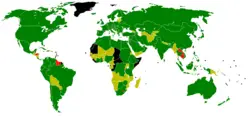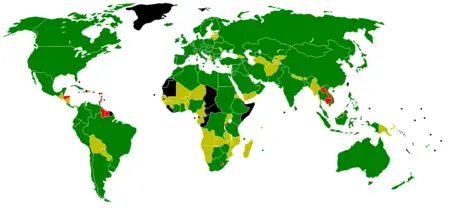International Organization for Standardization
- "ISO" redirects here.
| International Organization for Standardization Organisation internationale de normalisation | |
| Formation | February 23, 1947 |
|---|---|
| Type | NGO |
| Headquarters | |
| Membership | 157 members |
| Official languages | English and French |
| Website | www.iso.org |
The International Organization for Standardization (Organisation internationale de normalisation), widely known as ISO, is an international standard-setting body composed of representatives from various national standards organizations. Founded on February 23, 1947, the organization promulgates world-wide proprietary, industrial and commercial standards. As of May 2008, ISO is consisted of "national standards institutes of 157 countries, one member per country."[1], headquartered in Geneva, Switzerland.[2]
While ISO defines itself as a non-governmental organization, its ability to set standards that often become law, either through treaties or national standards, makes it more powerful than most non-governmental organizations. In practice, ISO acts as a consortium with strong links to governments.
Name and abbreviation
The organization's logos in its two official languages, English and French, include the letters ISO, and it is usually referred to by these letters. ISO is not, however, an acronym or initialism for the organization's full name in either official language. Rather, the organization adopted ISO based on the Greek word ἴσος (isos), which means equal. Recognizing that the organization’s initials would be different in different languages, the organization's founders chose ISO as the universal short form of its name. This, in itself, reflects the aim of the organization: to equalize and standardize across cultures.[3][4]
Benefits of Standardization
ISO highlights seven benefits of international standardization:
- make the development, manufacturing and supply of products and services more efficient, safer and cleaner
- facilitate trade between countries and make it fairer
- provide governments with a technical base for health, safety and environmental legislation, and conformity assessment
- share technological advances and good management practice
- disseminate innovation
- safeguard consumers, and users in general, of products and services
- make life simpler by providing solutions to common problems[5]
International Standards and other publications
ISO's main products are the International Standards. ISO also publishes Technical Reports, Technical Specifications, Publicly Available Specifications, Technical Corrigenda, and Guides.[6]
International Standards are identified in the format ISO[/IEC][/ASTM] [IS] nnnnn[:yyyy] Title, where nnnnn is the number of the standard, yyyy is the year published, and Title describes the subject. IEC is included if the standard results from the work of JTC1 (the Joint Technical Committee). ASTM is used for standards developed in cooperation with ASTM International. The date and IS are not used for an incomplete or unpublished standard, and may under some circumstances be left off the title of a published work.
Technical Reports can be issued when "a technical committee or subcommittee has collected data of a different kind from that which is normally published as an International Standard",Cite error: Closing </ref> missing for <ref> tag[7]
Members
ISO has 157 national members,[8] out of the 195 total countries in the world.
ISO has three membership categories:
- Member bodies are national bodies that are considered to be the most representative standards body in each country. These are the only members of ISO that have voting rights.
- Correspondent members are countries that do not have their own standards organization. These members are informed about ISO's work, but do not participate in standards promulgation.
- Subscriber members are countries with small economies. They pay reduced membership fees, but can follow the development of standards.
Participating members are called "P" members as opposed to observing members which are called "O" members.
Products named after ISO
The fact that many of the ISO-created standards are ubiquitous has led, on occasion, to common usage of "ISO" to describe the actual product that conforms to a standard. Some examples of this are:
- CD images end in the file extension "ISO" to signify that they are using the ISO 9660 standard filesystem as opposed to another file system - hence CD images are commonly referred to as "ISOs". Virtually all computers with CD-ROM drives can read CDs that use this standard. Some DVD-ROMs also use ISO 9660 filesystems.
- Photographic film's sensitivity to light, its "film speed," is described by ISO 5800:1987. Hence, the film's speed is often referred to as its "ISO number."
ISO/IEC Joint Technical Committee 1
To deal with the consequences of substantial overlap in areas of standardization and work related to information technology, ISO and IEC formed a Joint Technical Committee known as the ISO/IEC JTC1. It was the first such committee, and to date remains the only one.
Its official mandate is to develop, maintain, promote and facilitate IT standards required by global markets meeting business and user requirements concerning
- the design and development of IT systems and tools
- the performance and quality of IT products and systems
- the security of IT systems and information
- the portability of application programs
- the interoperability of IT products and systems
- the unified tools and environments
- the harmonized IT vocabulary, and
- the user-friendly and ergonomically-designed user interfaces.
There are currently 18 sub-committees:
- SC 02 - Coded Character Sets
- SC 06 - Telecommunications and Information Exchange Between Systems
- SC 07 - Software and System Engineering
- SC 17 - Cards and Personal Identification
- SC 22 - Programming Languages, their Environments and Systems Software Interfaces
- SC 23 - Removable Digital Storage Media Utilizing Optical and/or Magnetic Recording * Technology for Digital
- SC 24 - Computer Graphics and Image Processing
- SC 25 - Interconnection of Information Technology Equipment
- SC 27 - IT Security Techniques
- SC 28 - Office Equipment
- SC 29 - Coding of Audio, Picture, and Multimedia and Hypermedia Information
- SC 31 - Automatic Identification and Data Capture Techniques
- SC 32 - Data Management and Interchange
- SC 34 - Document Description and Processing Languages
- SC 35 - User Interfaces
- SC 36 - Information Technology for Learning, Education, and Training
- SC 37 - Biometrics
Membership in ISO/IEC JTC1 is restricted in much the same way as membership in either of the two parent organizations. A member can be either participating (P) or observing (O) and the difference is mainly the ability to vote on proposed standards and other products. There is no requirement for any member body to maintain either (or any) status on all of the sub-committees. Although rare, sub-committees can be created to deal with new situations (SC 37 was approved in 2002) or disbanded if the area of work is no longer relevant.
IWA document
Like ISO/TS, International Workshop Agreement (IWA) is another armoury of ISO for providing rapid response to requirements for standardization in areas where the technical structures and expertise are not currently in place. The utility harmonizes technical urgency industrial wide.
Criticism
Except for a few ones[9], ISO standards are normally not available free of charge, but for a purchase fee[10] which has been seen by some as too expensive for small Open source projects[11].
ISO has garnered criticism for the handling of the standardization process of the recently approved ISO/IEC 29500 Office Open XML) and the ISO rubberstamping of OASIS approved standards like ISO/IEC 26300 OpenDocument. Martin Bryan, Convenor of ISO/IEC JTC1/SC34, and WG1, is quoted by saying:
I would recommend my successor that it is perhaps time to pass WG1’s outstanding standards over to OASIS, where they can get approval in less than a year and then do a PAS submission to ISO, which will get a lot more attention and be approved much faster than standards currently can be within WG1
The disparity of rules for PAS, Fast-Track and ISO committee generated standards is fast making ISO a laughing stock in IT circles. The days of open standards development are fast disappearing. Instead we are getting 'standardization by corporation'[12]
Computer security entrepreneur and Ubuntu investor, Mark Shuttleworth, commented on the Standardization of Office Open XML process by saying
I think it de-values the confidence people have in the standards setting process,” and that ISO did not carry out its responsibility.
He also noted his opinion that Microsoft had intensely lobbied many countries that traditionally had not participated in ISO and stacked technical committees with Microsoft employees, solution providers and resellers sympathetic to Office Open XML.
When you have a process built on trust and when that trust is abused, ISO should halt the process ... ISO is an engineering old boys club and these things are boring so you have to have a lot of passion … then suddenly you have an investment of a lot of money and lobbying and you get artificial results ... The process is not set up to deal with intensive corporate lobbying and so you end up with something being a standard that’s not clear.[13]..
See also
- American National Standards Institute (ANSI)
- Deutsches Institut für Normung, German Institute for Standartization (DIN)
- British Standards
- Countries in International Organization for Standardization
- European Committee for Standardization (CEN)
- Commonwealth of Independent States (CIS) set of standards (GOST)
- International Classification for Standards
- International Electrotechnical Commission (IEC) and ISO/IEC standards.
- International Telecommunication Union (ITU)
- ISO A4
- ISO country code
- List of ISO standards
- Standardization
- Standards organization
- Terminology planning policy
- Bureau of Indian Standards (BIS)
Notes
- ↑ About ISO, ISO. Retrieved April 29, 2008.
- ↑ Discover ISO – Meet ISO. ISO (© 2007). Retrieved 2007-09-07.
- ↑ ISO's name. ISO (2007). Retrieved 2007-09-07.
- ↑ Discover ISO – ISO's name. ISO (2007). Retrieved 2007-09-07.
- ↑ {http://www.iso.org/iso/about/discover-iso_what-standards-do.htm Discover ISO], ISO. Retrieved April 29, 2008.
- ↑ The ISO directives are published in two distinct parts:
* ISO Directives, Part 1: Procedures for the Technical Work. 5th Edition (pdf). ISO/IEC (2004). Retrieved 2007-09-07.
* ISO Directives, Part 2: Rules for the structure and drafting of International Standards. 5th Edition (pdf). ISO/IEC (2004). Retrieved 2007-09-07. - ↑ Free ANSI Standards. Retrieved 2007-06-19.
- ↑ General information on ISO. ISO (© 2007). Retrieved 2007-09-07.
- ↑ Freely Available Standards. ISO. Retrieved 2008-04-26.
- ↑ Shopping FAQs. ISO. Retrieved 2008-04-26.
- ↑ Jelliffe, Rick (2007-08-01). Where to get ISO Standards on the Internet free. oreillynet.com. Retrieved 2008-04-26.
- ↑ Report on WG1 activity for December 2007 Meeting of ISO/IEC JTC1/SC34/WG1 in Kyoto. boycottnovell.com (November 29,07).
- ↑ Ubuntu’s Shuttleworth blames ISO for OOXML’s win. ZDNet.com (April 01,08).
ReferencesISBN links support NWE through referral fees
External links
All links retrieved April 29, 2008.
- ISO's official website (free access to the catalogue of standards only, not to the contents)
- Publicly Available Standards (free access to a small subset of the standards)
- The ISO Standards Glossary
- ISO/IEC JTC1
- ISO Advanced search for standards and/or projects (search engine by/on ISO)
Credits
New World Encyclopedia writers and editors rewrote and completed the Wikipedia article in accordance with New World Encyclopedia standards. This article abides by terms of the Creative Commons CC-by-sa 3.0 License (CC-by-sa), which may be used and disseminated with proper attribution. Credit is due under the terms of this license that can reference both the New World Encyclopedia contributors and the selfless volunteer contributors of the Wikimedia Foundation. To cite this article click here for a list of acceptable citing formats.The history of earlier contributions by wikipedians is accessible to researchers here:
The history of this article since it was imported to New World Encyclopedia:
Note: Some restrictions may apply to use of individual images which are separately licensed.

